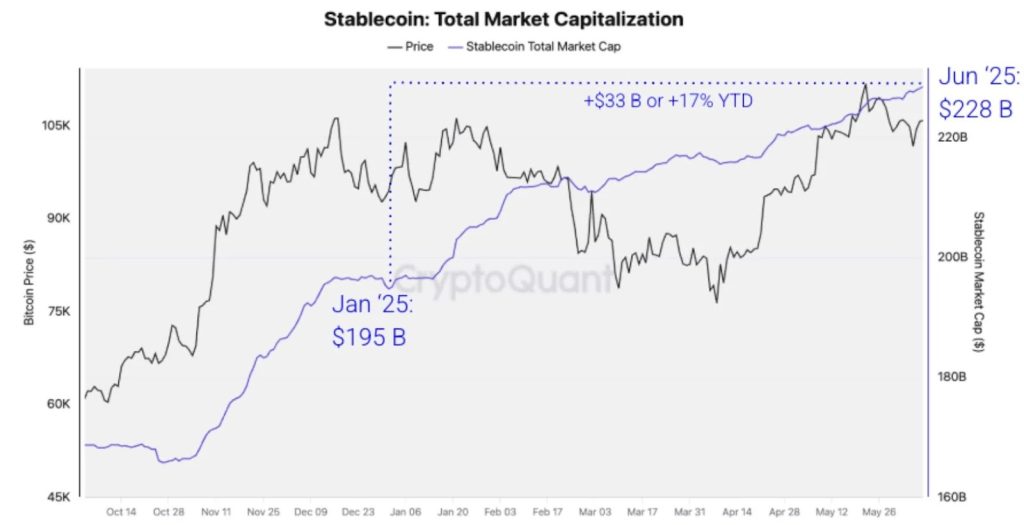Stablecoin Market Explodes to $228B in 2025: Trump-Era Regulations Fuel Trading Frenzy
Stablecoins just smashed records—again. The $228 billion market cap milestone isn’t just a number; it’s a middle finger to volatility. Here’s how Washington’s regulatory clarity (yes, really) lit the fuse.
Trump’s Legacy: Red Tape Turned Rocket Fuel
Love him or hate him, the 45th president’s crypto framework did what decades of bureaucratic hand-wringing couldn’t: gave institutions an on-ramp. Now Wall Street’s playing catch-up—with BlackRock’s USD ETF approval looking downright prescient.
Trading Volumes Go Vertical
Forget ‘slow and steady.’ Daily stablecoin settlements now eclipse Visa’s quarterly revenue. DeFi’s eating TradFi’s lunch, and the suits are finally noticing. (Better late than never, guys.)
The Cynic’s Corner
Of course banks are ‘exploring stablecoin integration’ now—nothing motivates finance like FOMO and shrinking profit margins. Welcome to the party, dinosaurs.
What’s Next? The $500B question. With CBDCs looming and algorithmic stables making a comeback, buckle up. This train’s leaving the station—with or without you.
 Source: CryptoQuant.
Source: CryptoQuant.
USDT and USDC Lead $33B Market Cap Jump
According to the report, Tether (USDT) and Circle’s USDC continue to lead the market. USDT now holds a $155 billion market cap, up $18 billion year-to-date. USDC has gained $17 billion, climbing to a record high of $61 billion, an increase of 39% since January.
On centralized exchanges, stablecoin reserves are also surging. The total value of ERC-20 stablecoins held on exchanges has reached $50 billion.
Stablecoins are booming again.
Market cap hit a record $228B, up $33B (+17%) in 2025.
Driven by rising trading activity, growing payment use, and clearer U.S. regulation under Trump. pic.twitter.com/76zKj49UWB
USDC reserves in particular have grown 1.6 times in 2025 alone, now totaling around $8 billion. This influx supports deeper liquidity for crypto markets.
The report also noted that stablecoins are bouncing back in the yield-bearing segment. These are stablecoins that pay interest to holders, often used in DeFi. The value of staked stablecoins has reached $6.9 billion, up 28% since late May.
Most of that growth has come from rising demand for sUSDe and sUSDs, which gained $1.23 billion and $700 million in market cap, respectively.
A recent report from on-chain data platforms Artemis and Dune shows broader user adoption. According to the report, titled “The State of Stablecoins 2025,” active stablecoin wallets ROSE from 19.6 million to 30 million over the past year, a 53% increase.
The report said the data “suggests wider user engagement” and pointed to stablecoins becoming a key part of digital finance. It also noted that stablecoins are increasingly used in decentralized finance (DeFi), gaming, and NFTs.
“Stablecoins have emerged as a bridge between traditional finance and crypto,” it said, “and are becoming a Core piece of payment and settlement infrastructure.”
This surge in usage is also supported by the rise in real-world payment activity. Data from Artemis shows $94.2 billion in stablecoin transactions were settled between January 2023 and February 2025.
Business-to-business (B2B) payments made up the largest chunk, reaching an annual run rate of $36 billion. Card-linked payments using stablecoins crossed $13 billion in volume.
Stablecoin Legislation Gains Ground as Tech and Finance Giants Pile In
Increased demand has also come alongside progress on the regulatory front. For example, the U.S. Senate advanced the “Guiding and Establishing National Innovation for U.S. Stablecoins Act” or GENIUS Act this week.
Backed by President Trump, the bill is designed to create a federal framework for dollar-backed stablecoins.
The legislation WOULD require stablecoins to be fully backed by U.S. dollars or highly liquid assets. It would also mandate annual audits for issuers with over $50 billion in market cap, and include requirements for foreign issuers.
![]() The U.S. Senate Set for Historic Stablecoin Showdown as GENIUS Act nears final vote.#Stablecoins #GeniusActhttps://t.co/ZJ59XzuQcn
The U.S. Senate Set for Historic Stablecoin Showdown as GENIUS Act nears final vote.#Stablecoins #GeniusActhttps://t.co/ZJ59XzuQcn
The Senate voted 68-30 to invoke cloture on the bill, clearing the way for final debate and vote.
“This did not happen by accident,” said Senator Tim Scott, one of the bill’s co-sponsors. “To those who said Washington could not act… let’s prove them wrong.”
Treasury Secretary Scott Bessent backed the legislation during a Wednesday Senate hearing. He said stablecoins could play a major role in expanding the use of the U.S. dollar globally.
“I think $2 trillion is a very reasonable number,” Bessent said, referring to an estimate that the stablecoin market could exceed that level by 2028. “I could see it greatly exceeding that.”
![]() BREAKING – U.S. Treasury Secretary Bessent:
BREAKING – U.S. Treasury Secretary Bessent:
– Stablecoin regulations backed by U.S. Treasuries will expand global USD usage
– We could see stablecoin demand exceed $2 TRILLION
This is massive for crypto.
Regulated stablecoins = institutional trust
Institutional trust =… pic.twitter.com/inZh9maAwW
The GENIUS Act appears to be pushing traditional finance further into the stablecoin space. Large U.S. banks, including JPMorgan, Citigroup, Wells Fargo, and Bank of America, are reportedly exploring a joint stablecoin project.
Meanwhile, USDC issuer Circle went public earlier this month, with shares jumping 160% on their first day of trading.
![]() @Circle the company behind the USDC stablecoin, made a dramatic entrance on the NYSE with its shares surging as much as 160% during its trading debut. #Circle #NYSE https://t.co/EJQJ4Yy3m3
@Circle the company behind the USDC stablecoin, made a dramatic entrance on the NYSE with its shares surging as much as 160% during its trading debut. #Circle #NYSE https://t.co/EJQJ4Yy3m3
Tech firms are also watching closely. According to Fortune, Apple, Google, Airbnb, and Elon Musk’s X are all exploring stablecoin integrations. Google has already processed two stablecoin payments.
![]() Apple, X, and Airbnb are in early talks with crypto firms to integrate stablecoin payments.#apple #google #stablecoinhttps://t.co/gmEbx3i4PN
Apple, X, and Airbnb are in early talks with crypto firms to integrate stablecoin payments.#apple #google #stablecoinhttps://t.co/gmEbx3i4PN
Airbnb has held talks with Worldpay to cut credit card fees using stablecoins. X is reportedly planning to include stablecoins in its X Money app.

